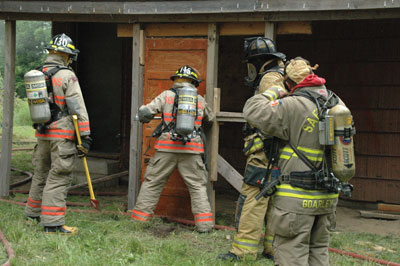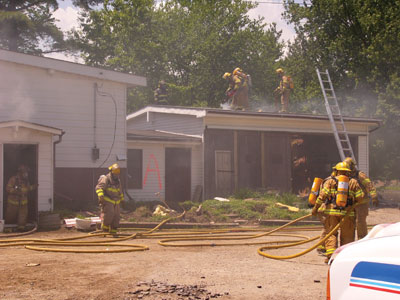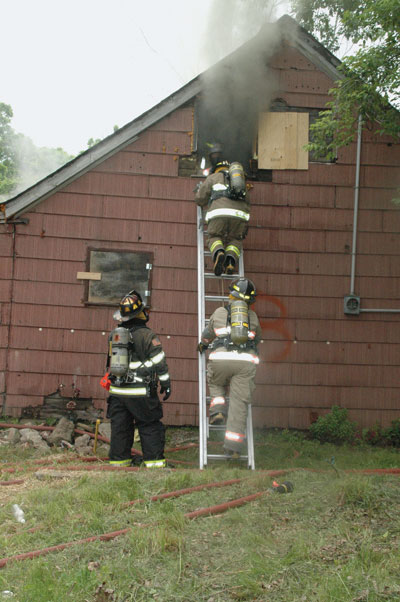
News
Live burn – part 2
CURRENT ISSUE
Live burn – part 2
Mark van der Feyst addresses the objectives and limitations of live fire training exercises.
January 5, 2011
By Mark van der Feyst
In the July 2010 issue of Canadian Firefigher and EMS Quarterly we discussed important factors to consider when setting up a live fire training exercise, including an acquired structure versus a fixed facility.

|
| Forcible entry can be incorporated into the scenarios during live fire training. (Photos by Mark van der Feyst)
|
Before embarking on live fire training, it’s important to set out the objectives of the exercise and recognize the limitations of this kind of training.

|
|
| Only the house portion, not the garage area, was being used for live fire training. This allowed crews to practise getting to the roof and cutting vent holes. | |

|
|
| Firefighters gaining entry and exit using a ground ladder. Advertisement
|
A live fire exercise is not the place to work on pump operations. In a live fire exercise, an experienced pump operator needs to be assigned to each apparatus being used as primary and secondary water supplies. This will ensure that there is no interruption in the water flow and that there is an adequate amount of pressure in the hand lines.
Live fire training is also not an appropriate setting in which to practise mayday drills. The term mayday should be reserved for actual emergencies so that when a mayday is called, it will be responded to appropriately, without confusion.
A major training component for all firefighters is the rescue of civilian victims from inside a structure. NFPA 1403 forbids the use of live victims any time fire is present but using training manikins in live fire exercises, nicely replicates the experience of rescuing real victims.
Live fire exercises are also not appropriate settings for flashover recognition training. Flashover training is valuable but only in a properly constructed container designed for this type of exercise. Using an acquired structure, or even a fixed facility, for flashover training will produce fatal results. If you are following NFPA 1403 correctly, there will be no flammable or combustible material inside an acquired structure or fixed facility such as furnishings, floor coverings or certain types of wall coverings. Without these items present, the chance of flashover is greatly reduced.
Ideally, fixed or acquired structure training should focus on the basics of fire fighting, including forcible entry, ventilation, search and rescue, laddering, hose advancement, fire attack and overhaul. Incident command can also be practised, provided there is an instructor with the student/firefighter who is in command.
Forcible entry
Forcible entry isn’t practised enough and some firefighters don’t have ample opportunity to use their skills. Forcible entry can be incorporated into the scenarios during live fire training. It’s easy to build a door prop for a fixed facility or acquired structure (see photo 14). The door in photo 1 was taken from the inside of the structure and was placed into a makeshift doorframe, using the front porch support posts. The door is not blocking any primary means of access or egress and it was designed to be away from the front door. The idea is to make the initial inside truck crew force open the “front door.” No attack crews can go into the structure until the door has been forced open. This part of the exercise must be timed with the ignition officers inside the structure. Once the door has been forced open, the inside truck crew can conduct its primary search.
Ventilation
There are several ways to practise ventilation; the easiest way is to practise hydraulic ventilation once the fire has been knocked down. It is essential to ensure proper instruction on hydraulic ventilation. It will be necessary to go to the roof to train firefighters to cut ventilation holes, but this may not be feasible on a fixed facility. This exercise goes hand in hand with laddering skills. Laddering the building to get to the roof, bringing up the required tools, sounding the roof and then cutting a vent hole are all part of one assigned task.
Using wooden skids on the roof of a fixed facility, students can practise cutting through wooden material with an axe or chainsaw. On an acquired structure, this can be accomplished by going onto the roof. Careful attention is needed to ensure that the roof can support the weight of the assigned crew. Some acquired structures will have enough roof space to allow a team to cut a series of vent holes without being over the top of the fire.
This practice is realistic, as firefighters are cutting through actual roofing materials to make a decent-sized vent hole. Using wooden skids also works, as described for the fixed facility.
Search and rescue
Every scenario should include a search for victims – or manikins. Search and rescue and the declaration of an “all clear” is a major benchmark that must be reached for all primary and secondary searches. I have seen instructors place victims (manikins) in unrealistic areas such as inside the fridge, on the top shelf of a closet or cupboard or stuffed in a hole in the wall. The four most common places in which victims are found are near windows, near doors, at the fire location and in their beds. Placing manikins in these locations gives firefighters an opportunity to exercise their search skills. We can also have manikins hanging halfway out the windows; this reinforces the need to do a complete walk-around and also allows for opportunities to practise using ladders to affect rescues from the outside rather than from the inside. Training on special tactics such as vent, enter and search (VES) is also a good way to reinforce the skills needed to rescue people. This requires a window prop to be built that allows firefighters to “break” glass and then enter a room. Knowledge about conducting VES is essential.
Laddering
Laddering can be incorporated into every assigned task. Hose lines can be advanced up a ladder, victims can be brought down a ladder, and ladders can be put up for firefighter survival reasons. One or two people can raise a ladder; the fire ground on the outside is a good place to practise laddering.
Hose advancement
Live fire training also affords a great opportunity to practise hose advancement. Depending upon the scenario, the attack crew and the backup line crew will be advancing hose up the stairs, down the stairs, around corners or even up ladders. This is also a good opportunity to practise advancing hose with two-person or three-person teams. Given that most departments operate with two- or three-person teams, this is the place to perfect the skills needed to advance hose.
Fire attack
Fire attack is the main reason we conduct live fire training. The opportunity to suppress a fire is not always available to all firefighters, so we must practise through training using class A materials or propane-fed towers. Usually live fire training involves an offensive attack; we rarely practise setting up a defensive attack first, then going offensive. The training ground is the perfect place to practise these different types of scenarios. During training, we can build a controlled fire in a safe setting and experiment with these different tactics.
Overhaul
In acquired structures, overhaul will be trained on at the conclusion of every evolution. Once the fire has been knocked down, overhaul has to take place; if overhaul is not accomplished, the whole structure will be lost with fire extending to the roof. In a fixed facility, the only way to practise this is by overhauling the burn pile. This is not very effective, but practise nonetheless.
Live fire training helps firefighters improve and develop everyday skills. As instructors, knowing exactly what you want to train on is the key to a successful live fire exercise.
Mark van der Feyst is an 11-year veteran of the fire service. He works for the City of Woodstock Fire Department in Ontario. Mark is an international instructor teaching in Canada, the United States and India. He is a local level suppression instructor for the Pennsylvania State Fire Academy, an instructor for the Justice Institute of British Columbia and a professor of fire science at Lambton College. E-mail him at Mark@FireStarTraining.com.
Print this page